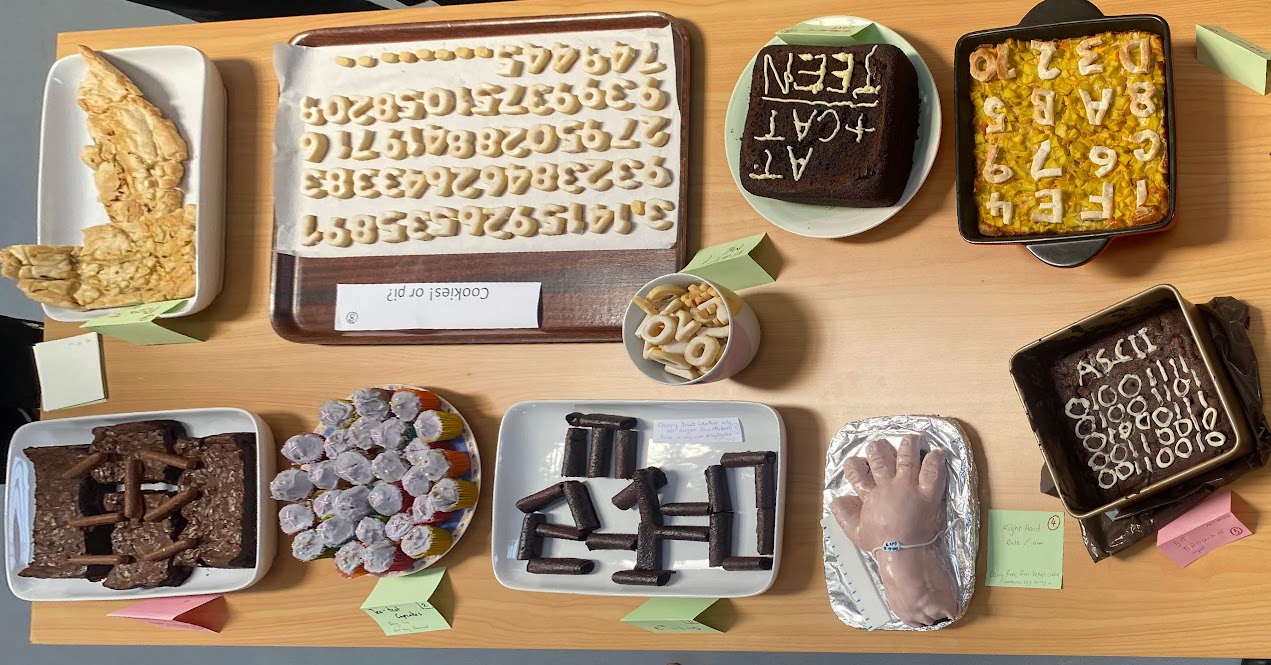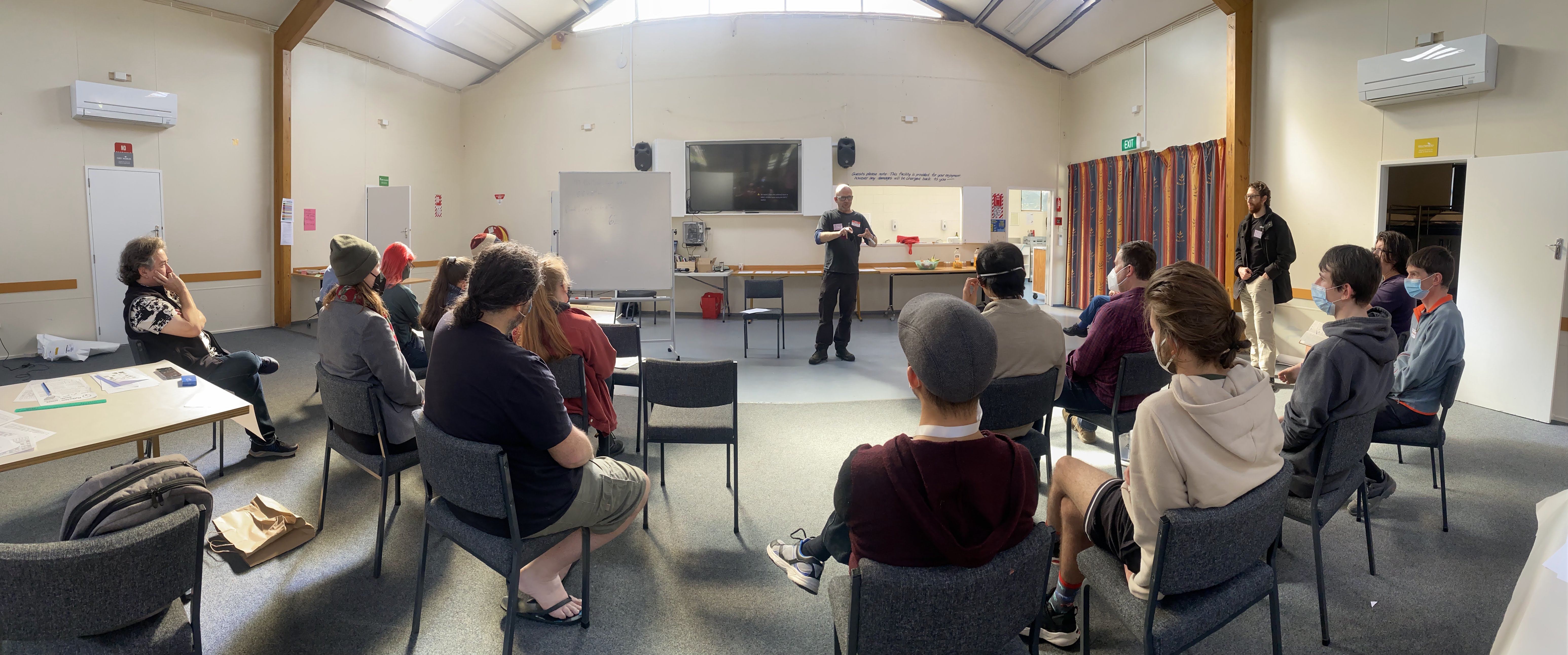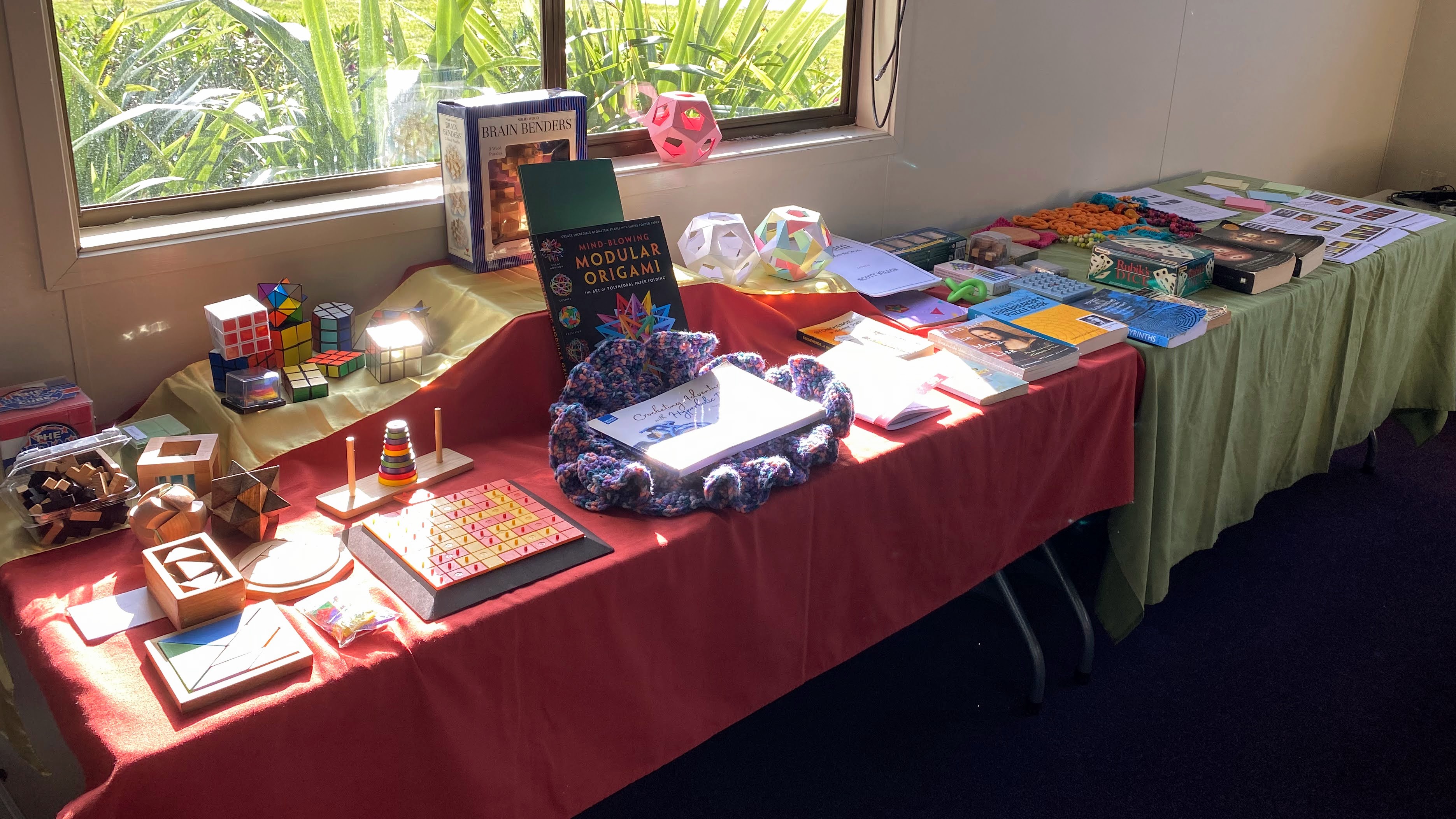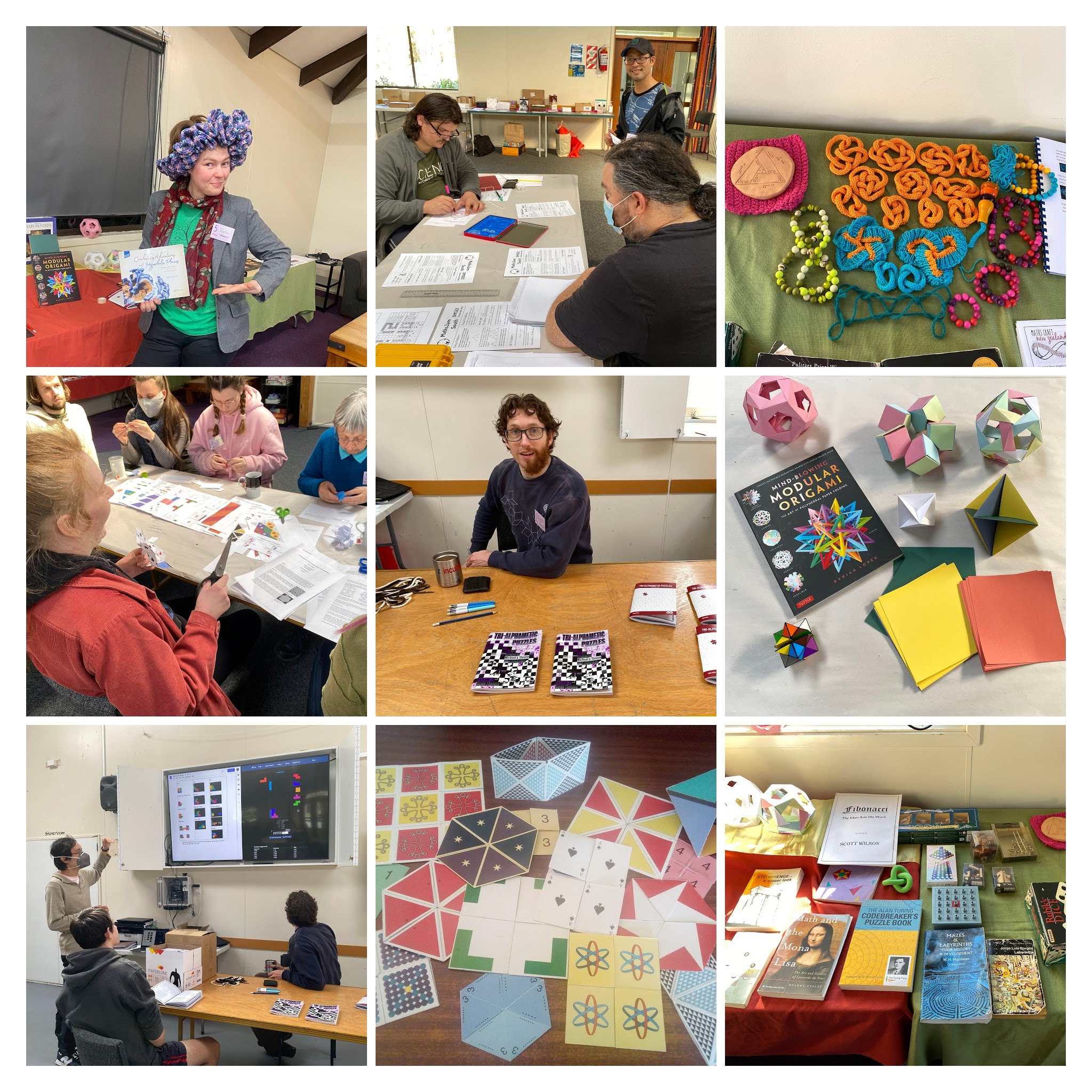2022 - Spencer Park, Christchurch
Keynote Talk: The Four Colour Theorem

We we lucky to have Dr Jeanette McLeod give the keynote talk for 2022, on the Four Colour theorem, one of the most controversial theorems of the 20th century. The theorem states that you only need to use four colours for any planar map, in order to ensure that no two regions that share a border have the same colour.
In her talk Jeanette discussed the history and approaches to the infamous theorem, from origin to (computer) proof, explained why mathematicians took over 100 years to solve it, and explored its links with all sorts of crafts.

Dr Jeanette McLeod is the co-founder and Director of Maths Craft New Zealand and is passionate about making mathematics accessible to everyone. She is a Senior Lecturer at the University of Canterbury and a Principal Investigator in the New Zealand Centre for Research Excellence, Te Punaha Matatini. Jeanette carries out research in the areas of pure and applied graph theory, and in mathematics education. She also knits, crochets, and sews – a lot!
Be sure to check out the wonderful resources provided by Maths Craft New Zealand linked in the Sunday Tables section below.
The Great Mathematical Bake off

Entries:
- Brownies of Königsberg by Rata
- Tea-test cupcakes by Amy
- Euler's identity (cherry fruit leather) by Elizabeth
- Right hand rule / lim(b) by Sophie
- Bit brownie by Andre
- Magic Square (bacon and egg pie) by Scott
- Alphametic Cake by Ross
- Cookies or Pi?(photos/bakeoff_8.jpg) by Tom
- Pizza bread Tau by Louis
Winner of best mathematics: #1 (Rata)
Winner of best looking: #4 (Sophie)
Winners of best tasting: #3 (Elizabeth) and #5 (Andre)
Competition Competition

- Unique Picture - Rata
- Meta Meta Competition - Scott
- Moderate Interval Competition - Kirk
- Stupidly Unfashionable Competition - Kirk
- Cancelling Competition - Kirk
- Confetti Confusion - Sophie
- Lukewarm Value Competition - Kirk
- Puzzle Vision Competition - Rata
- Maths Pun Movie Title Competition - Rata
- Match the Image with the Mathematical Caption - Elizabeth
- Hashi - Sophia
- NZ Apricots Preserve - Chris
- Pick the Median Number - Amy
- Guess the total N. or entries - Andre
- The Ross wins competition - Ross
- Write a Haiku about female mathematician - Elizabeth
See a selection of the competition competition entry forms here.
Most entries: Unique Picture (325 enties)
Voted best competition by a panel of judges: Moderate Interval Competition
Best circumvention of the rules without being eliminated: Rata
Open Mic Maths
 Open Mic Maths is essentially the “Hello, my name is…” sticker for OMG. It’s a lightning, 5 minute, informal talk about anything maths related. Read the talk summaries from our 2022 attendees below.
Open Mic Maths is essentially the “Hello, my name is…” sticker for OMG. It’s a lightning, 5 minute, informal talk about anything maths related. Read the talk summaries from our 2022 attendees below.
Open Mic Maths Session A
Chris Wong: The mathematics of Tetris
Tetris involves many mathematical concepts. In particular, we can define a parity function that categorizes a Tetris board as even or odd. We define two such parity functions, and apply them to the "perfect clear" minigame.
The video shown in the talk is: 10 perfect clears in 27 seconds by smolfeesh
Elizabeth Chesney: Field notes on the Fields Medal
Elizabeth gave a talk on everything you might want to know about the Fields medal, an award for outstanding contributions to mathematics. She covered how it was established, the age and gender of its winners so far, who didn't want it, and which countries come out on top for most wins (including by NZ's favourite metric, per capita).
View the slideshow
Todd Rangiwhetu: "Mind-reading" with cards
Todd picked two members of the audience - David W, one of the newest OMG attendees, and Rata, the longest-standing organiser for OMG - to help him with a trick. While Rata was sent outside, David freely picked a number between 1 and 31, and told Todd and the audience. Then, Todd laid five cards picked by the audience from a shuffled deck on a chair, some face up, some face down. When Rata came back, using just the powers of her mind, she "divined" David's number was 24. How did she do it, and how did Todd place the cards?
Tom Vavasour: How many digits of Pi do we really need?
Having done another 180 on his OMG2021 opinion that tau is a much better circle constant than pi, Tom spoke about the digit distribution of the decimal expansion of the constant (a practical matter, after he realised his bakeoff entry, Cookies or Pi?, was short a few 9's, and had some 0's in excess). He then showed that we don't actually need all that many digits of pi in order to measure the size of the observable universe to the grain of the Planck length.
Ross Atkins: What are Tri-Alphametic Puzzles?
Ross launched his book of tri-alphametic puzzles (available here). A tri-alphametic is a set of three sums, in which the digits have been replaced by letters. The same letter always represents the same digit in all three sums and the leftmost letter of each word never represents the digit zero. Clever problem solvers enjoy the challenge of trying to determine which letter represents which digit.
Open Mic Maths Session B
David Eddy: Fractals
David gave an short open mike talk on Fractals, marvelling at how such a simple equation could give rise to such complex patterns, also if nature had some hidden some fractal patterns into the DNA of trees and plants.
Pleayo Tovaranonte: Combinatorics in Rubik's Cube
Why is Pleayo's favourite number 43? Has it got anything to do with the answer to Life, the Universe, and Everything? And what is the minimum number of moves required to solve a Rubik's cube, anyway?
Check out Pleayo's slides here
James Bromby: Modular Origami pieces
James has been building some impressive modular origami. How much paper, and how many different colours, did he need to make a hollow dodecahedron (with none of the same colours touching)? What is the size of a face of an origami cube relative to the original piece of paper? How does it relate to a skeletal octahedron?
Scott Wilson: Fibonacci
Scott gave a brief summary of his Maths History essay on Leonardo Pisado (better known as Fibonacci): the man and his works. Fibonacci isn't just a sequence; his contributions to mathematics include Liber Abaci, a book which clearly explained the Hindu-Arabic numeral system to Europe, at a time when Roman numerals were still in use.
Scott has kindly provided us with the orignal paper he wrote in 2001 available to read here.
Phil Wilson: Dimensional Analysis
Phil gave a whiteboard talk on dimensional analysis, a simple algebraic procedure based on the observation that apples are not oranges which enables you to rapidly derive physical relationships between measurable variables in real-world problems.
Open Mic Maths Session C
Kirk Alexander: Poker Tactics
Kirk gave us a run-down on the relative likelihood of various hands coming up in Texas Hold'em Poker, explaining why the hand rankings are as they are. He defined named hands, showed how he calculated their respective probabilities, and compared these calculations with what you get in variations on the rules of poker, such as in a four-card hand, a stripped deck, or different numbers of suits.
Read Kirk's talk notes here
Andre MacLeod: Math Fails
There are many ways maths can go wrong (and not just by flipping the whiteboard only to see the equation you painstakingly prepared on the other side is now upside-down). From aviation fuel to Pepsi Co competitions, Andre gave us some examples of real life mathematical mistakes he'd encountered while reading Matt Parker's popular book, Humble Pi: A Comedy of Maths Errors (available to borrow from Christchurch City Libraries)
Ross Atkins: Tying Knots with Algebra
Knot theory is the study of mathematical entanglements. Very generally, knot theorists attempt to assign numbers to certain types of "knotted entanglements" in order to help understand their underlying invariant patterns. These numbers can also be surprisingly practical when it comes to the task of untangling the knot. With the help of four volunteers holding some rope, and two sorts of moves, the audience tied and then untied a real tangle, using numbers.
David Walle: the Hoffman-Sington Graph
David gave a talk on the Hoffman-Singleton graph, which is the largest known Moore graph. Moore graphs are interesting because they are very specific, created by considering strongly regular graphs (so all vertices have the same number of connections) which have a diameter, k, and the maximum possible number of nodes for their combination of vertex degree and diameter. There are only a few possible numbers of degrees, and therefore vertices. The only one which is not currently known is one with 3250 vertices all with degree 57, as it's hard to exclude all possibilities with larger graphs. There is a neat algebraic proof of the possible degrees (and hence vertices), so we know that there aren't more than the known ones and the d=57 one.
For further reading, he recommendes this AMS blog post by John Baez.
Louis Ammundsen: Negative Bases
Following on from his OMG2021 talk, Louis introduced another novel way of writing numbers - this time a system designed to negate any need for a minus sign (lest it get mistaken for a hyphen, for instance). We learned how to represent numbers using base negative 10, a.k.a "negadecimal."
View the slideshow.
Sophia Witham: Twist tile tessellation
Sophia introduced us to the mathematics of flat-foldable origami tessellations, showing many very cool examples including offset twist tiles. She recommends the definitive book on the topic, Twists, tilings and Tessellations: Mathematical Methods for Geometric Origami by Robert J. Lang for further reading (available on amazon)
Sunday Tables and display

Perfect clear Tetris: Chris's display was the consecutive perfect clear world record by smolfeesh. It is accompanied by the pattern guide linked here.
Flexagons: Josie brought along a fascinating selection of flexagons to endlessly fold. Many of the resources can be found in The Magic of Flexagons: Manipulative Paper Puzzles to Cut Out and Make by David Mitchell (available on amazon)
String art and crochet: Rata provided coloured yarn and crochet hooks (for making crochet hyperbolic planes), and darning needles and drilled MDF circles (for string art curves). Activities based on the book Crocheting Adventures with Hyperbolic Planes by Daina Taimina (amazon) and these resources from Maths Craft NZ respectively.
Maths Craft New Zealand: Jeanette and Phil brought a number of excellent resources from their organisation Maths Craft NZ, including Möbius strips and Origami and the Martin Gardner's prank Four Colour Theorem colouring sheet.
Maths Craft New Zealand is a non-profit initiative founded in 2016 and run by mathematicians Dr Jeanette McLeod and Dr Phil Wilson from the University of Canterbury. Together with the rest of the Maths Craft Team, they bring maths to the masses by celebrating the links between mathematics and craft. Maths Craft’s aim is to show young and old alike the fun, creativity, and beauty in mathematics through the medium of craft, and to demonstrate just how much mathematics there is in craft. After all, maths is everywhere!
Alphametic book: Ross Atkins has published a book of Alphametic puzzles, so let's plug it! Inspired during last year's OMG and launched during his Open Mic Maths talk on Saturday, Ross set up shop (literally) during Sunday tables, selling copies of Tri-Alphametics Volume 1 available to purchase online here and a similar book of Alphametic puzzles by Michael Linton, OMG21 keynote speaker. Note there is a hidden meta-puzzle in Ross's book – the first to solve it will win a $500 cash prize.
Selection of puzzles: As keen puzzle lovers, many MathsJam Gathering attendees brought along their favourite examples of puzzles, from the simple Rubik's cube (and many variants); wooden burr and tray-fit puzzles; wire twisty puzzles and more.
Display: Not only did we see puzzles, but also other interesting curios, such as to a clay tablet inscribed with cuneiform; a spirograph; 3D printed, beaded-string and french-knitted knots; papers authored by attendees; books on mathy topics from code breaking to labyrinths; and modular origami.

Photo Gallery
Check out this selection of photos from the weekend here
Other Resources
- OMG in the news: Rata on RNZ with Jesse Mulligan
- Event Programme,
- The South day 1 and day 2,
- Puzzlehunt,
- MathsJam Jam Songbook,
- Nonogram Puzzles, made using this website,
- Play Countdown online
- Letter puzzles: M, A, T, H, S, J, A, M
Thanks To
We’d like to thank our supporters for making this event possible:
- Barker’s of Geraldine,
- Chalkdust Magazine,
- Christchurch Tramway,
- Our donors (Angus and Gail theseventhletter.nz),
- James for printing,
- The organising team (Amy, Rata, Ross, Todd and Tom, and Huba for website)
If you think there is anything missing, you have additional materials that you would like to provide for the archives, or there is something you would like to have removed, do not hesitate to contact the organizers by email.